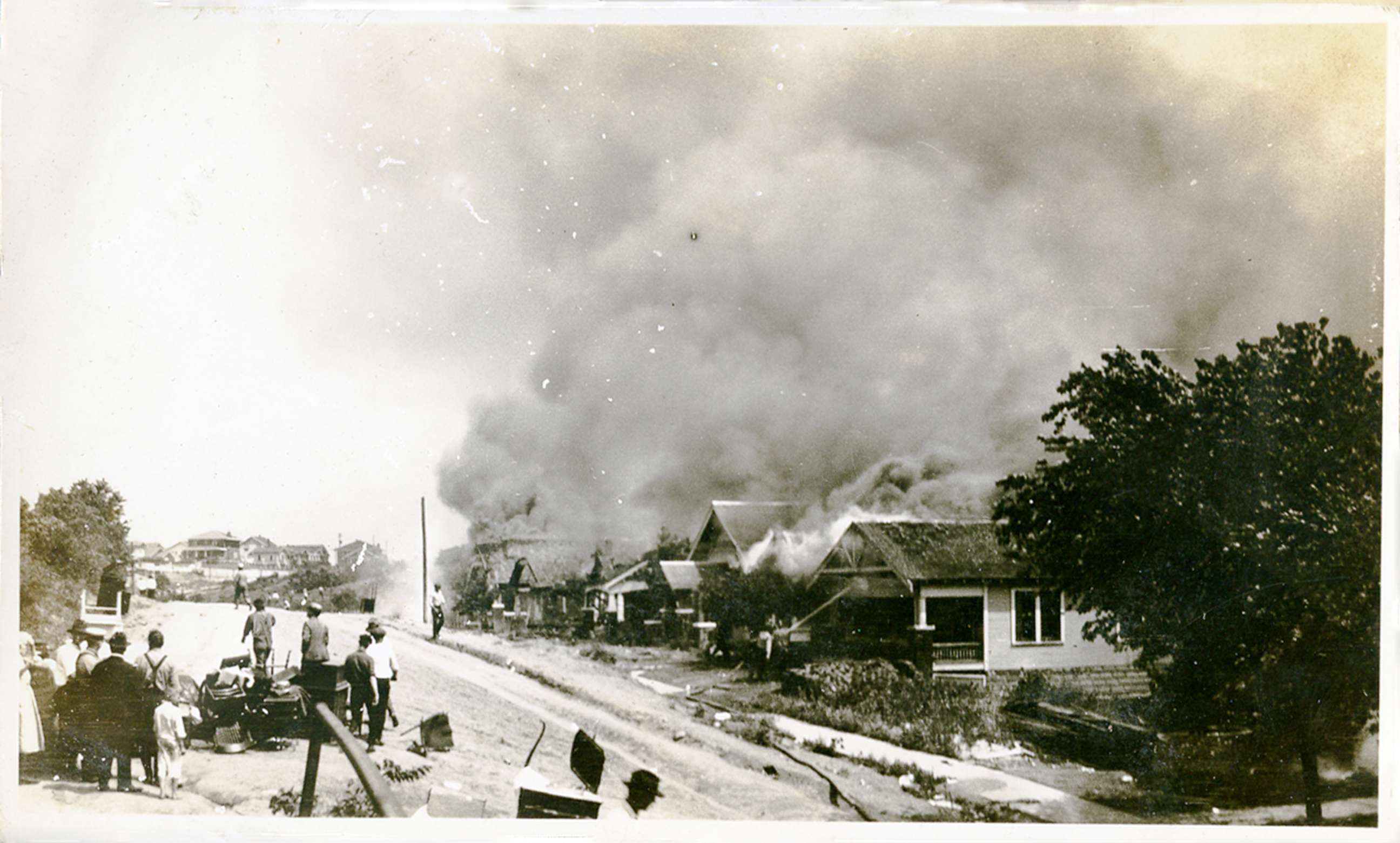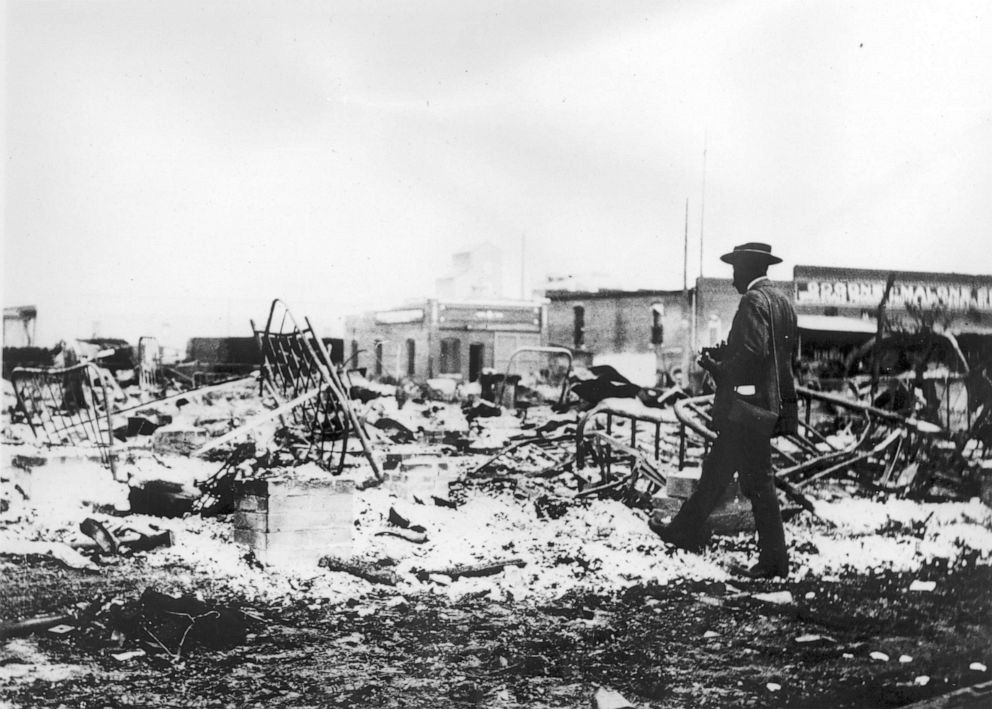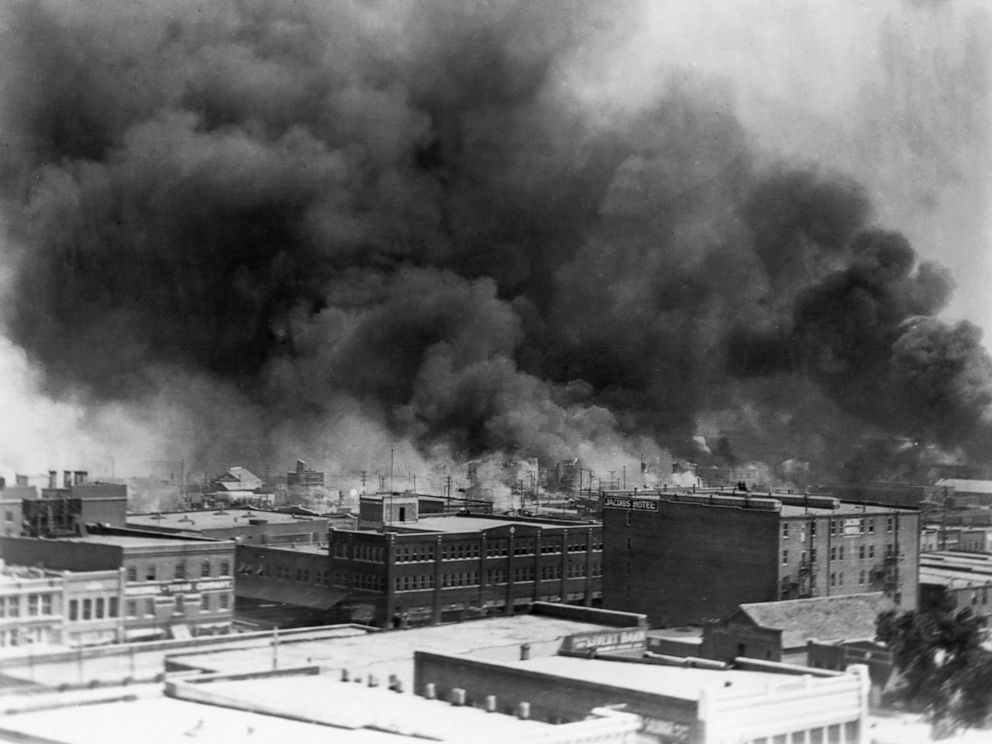Tulsa marks grim anniversary of 1921 'race massacre' as protests sweep the nation
Historians now believe as many 300 people were killed.
As protests against police brutality continue to spread across the country in the wake of the death of George Floyd, a black man who died after being pinned to the ground by a white Minneapolis, Minnesota, police officer, another Midwestern metropolis is preparing to mark the grim anniversary of one of the most violent attacks on African Americans in U.S. history.
The Tulsa Race Massacre began on May 31, 1921, and continued into the early morning hours of June 1. What began as a confrontation between groups of white and black residents following the arrest of a young black man ended in the destruction of 35 city blocks in the city's Greenwood District, an affluent area that had become known as "Black Wall Street," home to 1,200 black residents and 300 black-owned businesses.
In addition to the confrontation, many reports on the massacre say the success of the area also fueled the violence. Part of the official report on the massacre reads, "Many white Tulsans were especially incensed when black Tulsans disregarded, or challenged, Jim Crow practices. Others were both enraged at, and jealous of, the material success of some of Greenwood's leading citizens."
Newspaper reports following the massacre said only 36 people died, but historians now believe as many 300 people were killed as white mobs destroyed and burned homes, businesses, churches, schools, hospitals and libraries in the predominantly black area.
No one was prosecuted for those deaths or the destruction of property, and, nearly 100 years later, many victims of the massacre have not been identified because their remains have not been found and the event has been allowed to fade from the history books. It was only earlier this year that Oklahoma lawmakers announced a plan to include the 1921 Tulsa Race Massacre in the curriculums of all state schools.

Rev. Robert Turner, pastor of the Historic Vernon Chapel A.M.E. Church, one of the only buildings from that time that has survived to the present day, said he was surprised to learn of the event only after moving to the city three years ago.
"My first thought was 'Why is this not known?" Turner told ABC News. "Why are we not sharing this with the world?'"
Work is underway to revitalize Tulsa's Greenwood District ahead of the 100th anniversary of the massacre next year, and local leaders hope to mark the historic date with projects and programs that promote entrepreneurship, encourage cultural tourism and educate residents and visitors about an oft-overlooked tragedy.
"This happened, it's a part of our history," Phil Armstrong, project director of the 1921 Tulsa Race Massacre Centennial Commission, told ABC News. "Every other culture has an opportunity to address their past, things that were done to them and how they coped with that, dealt with that and still rose from that."
The event that sparked the Tulsa Race Massacre is reminiscent of more recent headlines. On May 31, 1921, Dick Rowland, a young black man, was riding in an elevator with a white woman named Sarah Page. Details about what happened in the elevator have never been confirmed, but reports say Page screamed and Rowland ran off. According to official reports on the event, Tulsa Police arrested Rowland the next day.

An article published in the local paper led members of the black community to believe Rowland would be lynched, so a group of black residents went to the courthouse where Rowland was being held, where they were confronted by a group of white residents. Shots were fired, witnesses interviewed in the weeks and months following the event said, but as black residents returned to the Greenwood District, they were followed by white mobs, who opened fire on black residents and began looting and setting fire to buildings. The violence lasted for several days.
The case against Dick Rowland was dismissed in September 1921. According to the official report, no attempt was made to prosecute anyone responsible for the deaths or destruction.
Black families displaced during the massacre lived in tent cities set up by the American Red Cross for months. The recovery process was slow and difficult, but Greenwood residents rebuilt their homes and businesses with almost no help from local, state or federal officials.
Tulsa historian Hannibal B. Johnson says the history of Greenwood is a testament to the spirit of the African Americans who pioneered the community.
"They suffered through the devastation of 1921 and rebuilt the community to a remarkable level and that's not known generally," Johnson told ABC News. "By 1925, the National Negro Business League had its national meeting here in Tulsa. The peak of this community as a business community was in the early to mid-1940s. There were well over 200 black owned businesses here."
In 2001, an official Race Riot (as it was then known) Commission was organized to review the details of the event and provide recommendations on providing reparations to survivors and their descendants. The commission's nearly 200-page report outlines the events of the massacre and identifies several victims based on historical reports and firsthand accounts, including several reports of victims being buried in mass graves.

Officials have identified three primary sites that could be the locations of mass graves connected to the 1921 massacre: Oaklawn Cemetery, Newblock Park and Rolling Oaks Memorial Gardens. A test excavation was scheduled to begin at Oaklawn Cemetery on April 1 but was postponed due to the COVID-19 pandemic. A new date for the excavation has not been set.
Current Tulsa Mayor G.T. Bynum is among local officials supporting a new effort to locate those graves and identify individuals buried in them.
"As we open this investigation 99 years later, there are both unknowns and truths to uncover," Bynum said in a statement. "We are committed to exploring what happened in 1921 through a collective and transparent process."
As crowds gathered outside Tulsa's City Hall Monday to protest the death of Floyd, Bynum invited them in to talk about racism and other issues plaguing the city.
In a Facebook post, he wrote, "99 years ago, our fellow Tulsans lost their lives because white Tulsans opted for violence instead of dialogue with black Tulsans. Today, this generation of Tulsans spent 3 hours in a room working through our differences on a number of important but challenging issues."




